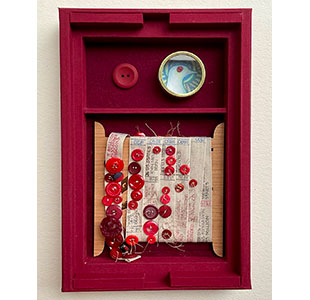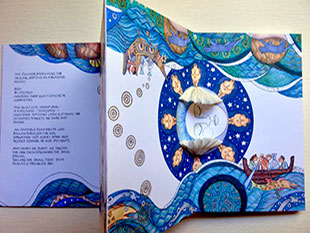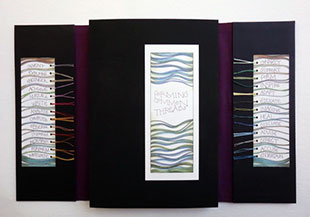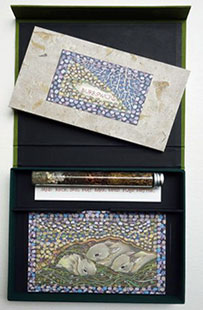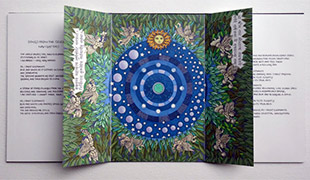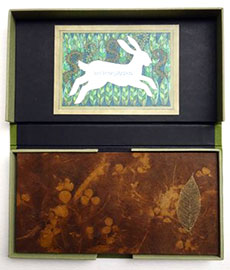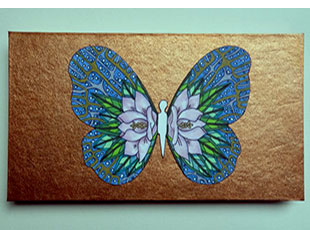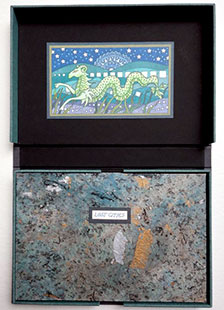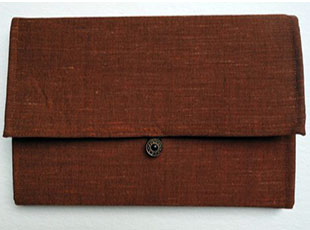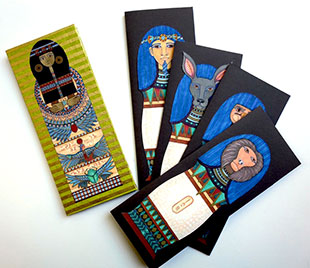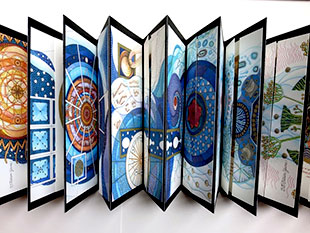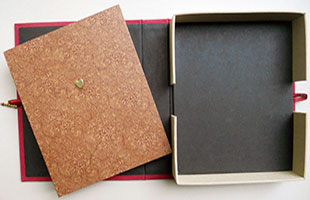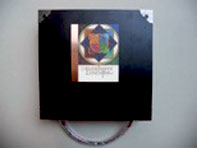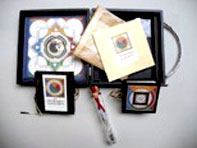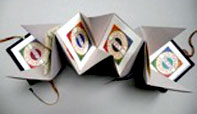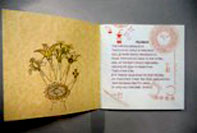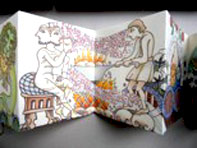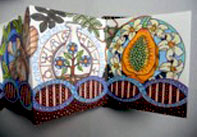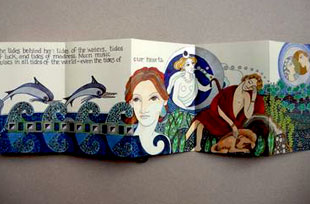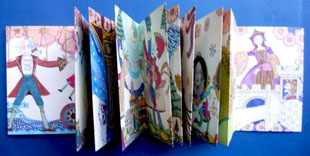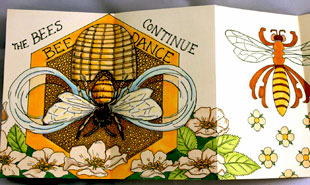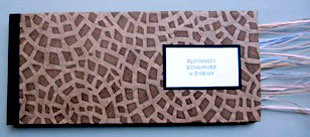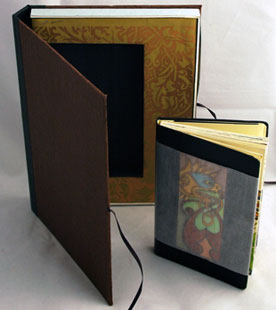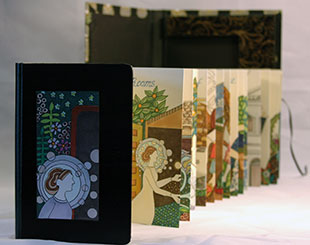
|
Mari Eckstein Gower ~ Washington |
Share this page:
|
| Gower graduated from Scripps College (BA in art and humanities) and Claremont Graduate University (MA in painting / photography). Afterward, she studied printmaking for two years in Montreal before moving back to the US. | |
| Picture Poem Books | |
Reliquary for Martha 11 x 7”; 14 spread. Inkjet printed on superfine cover paper. Materials: laser cut plexiglass; walnut and cherry woods; vintage buttons, linen tape, thread. Drum leaf binding with linen tape timeline on a 6 x 6 ½ x 1 in laser cut spool, extending to 76”. Housed in a 12 5/8 x 8 ¼ x 2 ¾” layered box. Signed and numbered by the artist. Text, paintings, and ecoprints by Mari Eckstein Gower. Mari Gower: "In 1914 Martha, the last passenger pigeon, died in the Cincinnati Zoo, becoming the icon for human-induced species extinction. 20 years earlier, people thought such an event impossible. At their peak the birds migrated in flocks numbering in the billions. They were the most numerous avian species on the planet. It's hard for those numbers to sink in. Even more difficult is that after 100 years of habitat loss and overhunting their numbers had reduced to zero. “For years this story has fascinated me. It's perhaps the most graphic example of an extinction event that is directly attributed to human activity. I've wanted to do an artist book about this subject for years. But it's taken me all this while to arrive at a way to do justice to the many facets of the story. “In ‘Reliquary for Martha’ I approach the subject from several directions: through words, images, and a 3-dimensional timeline to unspool the trajectory of my protagonists - humans and birds - one rising and the other in decline as the nineteenth century unfolds. I've chosen to riff on the concept of scientific specimen collections being a form of reliquary. Too often now they are the only place one can observe firsthand the remains of animals long extinct, as well as those that are sadly living on the brink.” |
|
Pandemic Dreams 10.75 x 7 x 1.25” closed, extends to 97. Accordion fold with 7 spreads. Inkjet printed on superfine cover paper, with additional papers of Canson Mi-Teintes, Madeleine Durham paste paper, Japanese Kozuke paper with Kozo fiber. Housed in a 11 3/8 x 7 5/8 x 2” clamshell box. Signed and numbered by the artist. Mari Gower: "Early in 2020, when it seemed that the entire world was in lockdown because of a new virus, I chanced upon a news article about how pandemic first responders reported dreams with common patterns. Doctors, nurses & paramedics were connected not just by shared trauma, but by communal dreams as well. “Wondering if these patterns repeated in the general populace, I began collecting quotes from global news articles which chronicled reactions to the unique times we were sharing. While doing so, I began painting dream-themes that reflected our collective dreaming. “’Pandemic Dreams’ is my exploration of how we have globally processed the stress of dealing with an invisible menace through our dreams. The front pages of my book explore how we regard masks as both protection and containment by using origami forms to cover parts of the faces. The waves in my paintings contain pleas for medical help in multiple languages. The back pages contain selections of the quotes I've collected from global news sources.” Text excerpt: “Even though I know the deaths are real, it feels more like I’m watching a dystopian or apocalyptic movie because, when I look out my front window, the world still looks the same as it always has.” |
|
Forming Common Threads 8 x 11" closed; 48 pages. Inkjet printing. Illustrations created from original watercolor and ink paintings. Materials: linen, silk and paper threads, Mohawk Superfine cover paper, Japanese Tarasen patterned papers, vellum paper. Bound with a modified stitched drumleaf format in cloth-covered boards. Gatefold cover. Art, design & text by Mari Eckstein Gower. Book fabrication by Kat Gower. Dated, signed and numbered by the artist. Mari Eckstein Gower, introduction: "'Forming Common Threads' examines how storytelling informs, inspires, and transforms our lives. I've taken stories of strong women from history and myth and used them as a form of antidote to the belittling, toxic and hurtful comments I grew up with. "Traditionally myths, histories, and all the best stories have been a means of communicating deep truths about human existence. Many of these tend to be cautionary tales such as beware of candy houses in the forest. The stories I find most appealing, however, are those about overcoming obstacles through courage, tenacity, and a willingness to look beyond the obvious. To me, these are the type of tales that form a thread of ideas with the power to inspire me to move forward. "When I was young, I was often told things like, 'Girls can't do that.' Instead of allowing such stifling comments stop me, I'd study historical examples as a form of psychic Band-Aid for the hurt. Looking at the accomplishments of women like Amelia Earhart or Nellie Bly, I'd think, 'Wait a minute. They didn't let being female stop them from flying an airplane or writing exposes.' "As I watch the growing momentum of the #MeToo phenomena lift veils of silence, I am awed by the power of the simple but brave act of telling one's story. The more often these stories are revealed, the stronger the fabric of truth. "All the quotes in this book are taken from my personal experiences. Remembering many of those conversations dredges up uncomfortable memories. Bu I've traveled back to those painful places because I feel strongly that the subject of this book deserves absolute honesty." |
|
Burrowers Book dimensions: 8.25 x 4.75" with 11 pages (9 pages recto only used, 2 pages pastedowns). Accordion spine. Pastedowns inkjet printed on Superfine cover paper from original ink & acrylic paintings. Art, design, & poetry by Mari Eckstein Gower. Fabrication by Kat Gower. Paper-covered boards with illustrated title label on cover. Laid in sectioned 7.25 x 9" custom box with magnet closure. Compartment for book with colophon tipped at bottom. Compartment for 6.75 x 1" test tube containing sand, rock, soil, peat, bark, moss, and plant matter. This edition of "Burrowers" is based upon a one-of-a-kind book made by the artist in 2015 to commemorate the United Nations Year of Soil awareness. Mari Gower: "Each time I dig in my garden, I’m reminded how alive and dynamic the soil is. As I work I encounter the obvious burrowers: rabbits, moles and other small mammals. My compost pile wriggles with insect life. But I’ve learned that soil is also home to less visible creatures such as bacteria, algae, fungi, and protozoa. "Using biochemical processes such as nitrogen fixation, these organisms affect the structure and stability of soil. They contribute to plant growth and the success of the overall soil ecosystem. "By many estimates, two thirds of the earth’s biodiversity lives in soil. These living communities help determine the unique character and geographic profile of soil worldwide. Although one gram of soil can contain billions of microorganisms, most of them are yet to be cataloged. This means there is much for us to discover about the creatures that live in soil." |
|
Holding up the Roof 8.5 x 5.5"; 10 pages (8 leaves + 2 pastedowns). Accordion spine. House- shaped cutout extends through the 8 leaves. Inkjet printed on superfine cover paper from original ink paintings. Art, design, and poetry by Mari Eckstein Gower. Fabrication by Kat Gower. Signed, dated, and numbered by the artist. Paper-covered boards with paper title label on front board. Laid in cloth-covered clamshell box with colophon tipped on bottom of tray. Pocket in lid of box interior holds house-shaped 2 x 3" miniature book (8 pages, twine and bead closure). Mari Gower: "According to my art history classes, architecture developed along a timeline of styles: Classical, Byzantine, Romanesque, Gothic, Renaissance, Baroque, Neoclassical, Eclectic & Modern. Those nine categories summed up western architecture. For most of those styles, tombs, temples, palaces, and cathedrals appear to be the only structures classified as architecture — the humble house is out of the picture. "Looking at architecture on the most basic level, all structures consist of mechanisms for supporting a roof over some form of enclosure. How that roof is formed and supported is what defines the differences between Classical, Romanesque, Gothic, etc. "My interest is in the absent pieces; homes of common people, and, more significantly, the people who do not or cannot have a roof overhead. "Holding Up the Roof explores how different architectural styles developed ways to support a roof and compares them with how we view and speak about the homeless." Quotations from architects through history grace the tops of the pages of Holding up the Roof while the miniature book has a series of quotations about homelessness. |
|
Songs of the Celestial Navigators 6.5 x 10.25" closed, extends to 59"; 12 pages. Triptych structure. Left and right panels accordion fold with four panels. Middle triptych panel a gatefold forming a triptych. Illustrations from original watercolor and ink paintings. Inkjet printed on superfine cover paper. Bound in cloth boards. Laid in four-flap portfolio wrapper. Statement and colophon tipped in wrapper. Embellished with elephant of carved bone on front long flap with window in top flap to view. Art, design & text by Mari Eckstein Gower. Fabrication by Kat Gower. Signed and number by the artist. Mari Gower: "I began this book during a period when I felt very anxious about world events. At the time, I happened to be researching several ancient cosmologies for a different project. I've always been fascinated by how the image of the world tree repeats in so many cultures. But my absolute favorite is the Hindu concept of the world elephants that support the earth as they ride through the universe on the back of a giant turtle. "I put aside my original project to paint elephants positioned around the trunk of the world tree. ... As I continued working on this book, I realized that it had become something like a little altarpiece to the Hindu deity Ganesha, the remover of obstacles. I included two Sanskrit invocations in the artwork. On the left side is the Vakratunda Ganesha mantra for the removal of all obstacles. To the right is a prayer for prosperity." |
|
The Bone Garden 4.25 x 8.25"; 14 pages. Single-sided accordion. Inkjet printed on superfine cover paper from original ink & acrylic paintings. Art, design, and poetry by Mari Eckstein Gower. Fabrication by Kat Gower. Bound in paper over boards with leaf enhancement on front board. Laid in cloth-covered tray clamshell box with finger holes on sides. Colophon tipped into base of box. Signed, dated, and numbered by the artist. Mari Gower: "I began The Bone Garden while undergoing physical therapy after knee replacement surgery. That difficult recovery period left me feeling depressed and broken. Being housebound during an unusually hot summer did nothing to relieve my desire to escape. When I looked out my windows, it seemed like I could actually watch the weeds overgrowing my garden. It seemed like an appropriate metaphor for what was going on with my body. "So I turned to art as a way to remind myself that even broken things can be rebuilt: knees can mend, souls can be revived and, eventually, gardens can be tended." |
|
Cupid and Psyche 8.25 x 4.25"; 16 pages. Accordion structure. Inkjet printed on superfine cover paper from original ink and acrylic paintings. Laid in custom box with compartment for book and one for clay butterflies. Colophon tipped in bottom of book compartment. Three handmade butterflies attached in base of second compartment. Butterflies made from metallic polymer clay and willow twigs. Art, design, and poetry by Mari Eckstein Gower. Fabrication by Kat Gower. Signed, dated, and numbered by the artist. Mari Gower: "Cupid and Psyche is a portion of a large one-of-a-kind piece commissioned for the Just One Look exhibition at the University of Washington, 2016. I used Sarah Ruden’s translation of The Golden Ass by Apuleius (Yale University Press, 2011) as my primary source material for the myth as well as the quotes from Venus on the butterfly wings, which appear in the book." Lauren Dudley, Just One Look exhibition catalogue: "The book opens with a cloud of butterflies against a smoky amethyst background and beautifully hand-lettered narration that begins 'This is not the hero’s saga. This is the maiden’s tale.' Gower’s finely detailed illustrations, replete with overlapping imagery, convey the intricacies of the tale. Incisive line—in colored and metallic inks— combines with delicate hues of acrylic paint to suggest the otherworldliness of a magical fable. In Gower’s rendition this Psyche is not empowered by her notable beauty. "Gower visually evokes the importance of gaze in Psyche’s tale by suffusing her work with symbolic all-seeing eyes, illustrating the many ways that a gaze changes the narrative in this story and suggesting as well the omniscience of the deities who watch over the mortal world." |
|
Lost Cities 8.5 x 5.75"; 22 pages. Double accordion. Inkjet printed on superfine cover paper from original ink paintings. Paper covered boards with paper title on front board. Art, design, and poetry by Mari Eckstein Gower. Fabrication by Kat Gower. Laid in cloth-covered drop spine clamshell box. Signed and numbered by the artist. Mari Gower: "While visiting the ancient Roman ruins at Osta Antica, I was surprised by how ‘alive’ the remains of that city felt to me. The elaborate mosaic floors and beautiful brickwork patterns on walls fascinated me. Many mosaics showed deities and mythological sea creatures, all of who seemed eager to tell their stories. "Now, I can never resist a good story. And, looking about those ruins, I thought about what old buildings reveal about past cultures. I think curiosity about buried and lost cultures is wired into the human brain. It seems part of understanding where we came from and who we are today. "I imagined creatures from the mosaics guiding me on a journey to explore the remains of legendary places like Atlantis, the hanging gardens of Babylon, and the library at Alexandria. On such a journey there are always things one can never know. But there are also many surprises along the way." |
|
Wanderjahr 8.4 x 5.5" closed. Accordion box structure that when extended forms a series of four 4-sided three-dimensional spaces. Inkjet printed on superfine cover paper from original ink and acrylic paintings. Art, design and poetry by Mari Eckstein Gower. Fabrication by Kat Gower. Paper covered boards with paper title label on front cover. . Laid in cloth wrapper with loop and button closure. Signed, dated and numbered by the artist. Mari Gower: "Wanderjahr is my love poem to books and their power to transport me to distant places and times. Books provide the perfect antidote for my annual winter cabin fever. For, even when I am secluded at home, books allow me to visit tropical islands, Renaissance Europe and even outer space." |
|
| Vessel from the Place of Truth By Mari Eckstein Gower Redmond, Washington: Mari Eckstein Gower, 2015. Edition of 15. Set of pamphlets and a book wrapped in cloth with tie closure. Inkjet printed on Superfine cover and Canson Mi-Teintes. Book: 10.75 x 4.6" closed, 12 pages; accordion fold; boards covered in gold leaf Lama-li papers; signed and numbered by the artist. "Vessel from the Place of Truth" pamphlet: 4.5 x 11", 10 pages; signed and numbered by the artist. Four pamphlets (one for each of the four sons of Horus): 4.5 x 11"; 4 pages. Pamphlets bound in brown paper wraps with image of each god on respective covers. Wrapped books laid in cloth covered clamshell box with scarab medallion on cover. Mari Eckstein Gower: "I've been interested in Egyptian art since childhood. I remember seeing the magnificent golden image of King Tut and pouring through books to look at the photos of strange animal-headed gods, lavish gold jewelry, and (of course!) mummies. … I dearly wanted to grow up to be an archaeologist and uncover the secrets of the tombs. "I never did become an archaeologist. But I still love pouring over books on the subject. I find one of the most interesting aspects is the ancient Egyptian burial beliefs and practices. In college I studied the Book of the Dead for one of my humanities projects. (I think some of the incantations read like poetry.) If possible, I try to attend any exhibit of Egyptian artifacts. A few years ago I attended an exhibition where rooms were set up like the interior of a tomb with a replica of the entire journey of the sun god through the Amduat (the Egyptian netherworld) painted on the walls. "Vessel from the Place of Truth": "Across from the grand pyramids of the Valley of Kings, is an area called the 'Place of Truth'. This Is where tombs of the artisans, scribes and overseers responsible for constructing those pyramids lie buried. … I've drawn inspiration from the tombs of that region to create my own imaginings of an Egyptian scribe's work. In the 'mummy' book, I have my imaginary scribe conveying information from 'The Book of the Dead' and the 'Hymn to Osiris' to create a long narrative, intended to help the deceased with his/her journey beside the sun god through the trials of the Amduat. "The four 'canopic jars' represent the containers for deceased's viscera, which would always accompany a mummy. Each of my 'jars' contains a page interpreting the organ's function, and a second page with my reimagining of a page of papyrus laid out with words and images from texts such as 'The Book of the Dead.'" $800 (Last Copy) |
|
| Circle or Zero Origins By Mari Eckstein Gower Redmond, Washington: Mari Eckstein Gower, 2014. Edition of 15. 4.75 x 12.25 x 1.25" closed, extends to 162"; 36 pages. Inkjet printing. Accordion structure. Foldouts from center of page forming a triptych. Papers: Superfine cover, Canson Mi-teintes, Strathmore drawing paper. Signed and numbered by the artist. Laid in cloth-covered clamshell box. Mari Eckstein Gower: "Sacred or Profane? It depends on one’s point of view. In my book I compare scientific vs. the metaphysical viewpoints. To do this I’ve examined different ideas about creation: contrasting a panoramic timeline of the Big Bang/evolution (scientific view) with altarpiece inserts (metaphysical). For this I’ve used such sources as; the Bible, ancient Egyptian incantations, the Rig-Veda, Poetic Edda, Popol Vuh and the Hawaiian Kumulipo." Mari Eckstein Gower, blog: "This was supposed to be a simple project; comparing the timeline of the Big Bang to creation stories from different cultures and religions. … I wanted everything to be based on the shape of a circle. (And no repeats! Each composition had to look at circles in different ways.) "My germ of an idea was a meditation on the differences between circle and zero. They both started out as the same shape. But the one is tied to the rules of geometry while the other (when one really starts to look into the concept) skirts the edge of metaphysics and the meaning of infinity. I soon discovered that, to honestly portray the Big Bang portion of the book, I had to understand the underlying physics (at least on the most simplistic level) of the theory. "The creation story part of the book presented another challenge. First, I had to decide which myths to include. I wanted to touch on as many cultures as possible , and include something from each continent. "When I finished, the book stretched out to 13.5 feet long when completely unfolded. The time line starts with the Big Bang and concludes with Darwin's finches. As the book unfolds, each page turn opens onto an altarpiece which contains a representation of one of the creation stories "Beneath these 'altarpieces' I've included a quote from the text that the story came from. Usually it was the first lines. I wanted to show how each story envisioned the inciting incident of creation. I looked at art from each culture, and used artifacts as reference for my images. For the Hindu story, I looked at Indian miniatures. For the Pelasgian story I looked at Greek black and red pottery." $900 (Last 2 copies) |
|
| Soldier's Heart By Mari Eckstein Gower Redmond, Washington: Mari Eckstein Gower, 2014. Edition of 40. 6 x 7.25" closed, extends to 154"; 26 pages. Accordion structure. Inkjet printed on Arches cover paper from original paintings. Bound in patterned paper with metal heart adornment on front cover. Laid in cloth-covered French tray clamshell box with ribbon and metal closure. Signed and numbered by the artist. Mari Eckstein Gower: "My father, like many who fought in World War II, suffered from nightmares triggered by his experiences. For his generation, this wasn’t something one spoke about, as if his responses were a weakness or shameful. I’m thankful that today the effects of trauma are being studied and treated, and that we’re beginning to understand that PTSD is not only a social issue but political as well. In my book, Soldier’s Heart, I explore the subject of PTSD, looking to historical portrayals of the effects of warfare and the ways PTSD has been described in the past. The book design is inspired by the Bayeux Tapestry, which is packed with surprising descriptive details. I’ve also referenced Egyptian, Assyrian, Mayan, and Celtic artifacts." $400 |
|
An Alchemist's Lunch Box |
|
Picture Poems |
|
Selene A custom-made book-like structure (6 x 8.5") with tie closure opens to reveal a Moleskine Japanese Accordion Album (3.5 x 5.625", 32 pages) lying in a cavity. The accordion opens to a 10' (prefolded paper) on which Gower has created original images, using black- and colored-ink pens. Mari Eckstein Gower: "One of my first steps in choosing a topic is giving myself a color scheme challenge. This time I wanted to work on the colour palate of the night sky and also to experiment with metallic inks. The subject of the moon goddess was a natural choice since I love just about anything that has to do with the myths about the stars, planets, moon. "I started out thinking about the scientific and folklore images of the moon differ from the Greek myth. Some people see a man in the moon, or a rabbit. But I can't help but think of the moon as a female – the Greek goddess Selene. In mythology, Selene is sister to Helios, the sun. He leads the way across the sky, but once the Goddess Nix raises her hand to bring on the night, and the evening star rises, the whole show belongs to the moon. I loved the image of all those gods and goddesses riding in a procession. "The myths about Selene do not agree about what animal pulls her chariot. In some versions it is a team of oxen, while in others it is moon white horses. The museum in Athens has a beautiful dramatic statue of the head of one of Selene's horses. The image is so dynamic, I couldn't resist creating my own version. "Selene has many children, including the fates and the seasons. The four seasons were a popular motif for Roman floor mosaics (which inspired my depiction here.) I saw a lovely example displayed in the museum in York, England, that dates back to the Roman occupation of that town. "In the final panels of the book I portrayed night creatures associated with Selene, observations about the tides, and lastly bits of the Endymion [the most handsome mortal beloved by Selene]legend." |
|
| I Sail My Ship of Dreams By Mari Eckstein Gower Redmond, Washington: Mari Eckstein Gower, 2011. One-of-a-Kind. A custom-made book-like structure (6 x 8.5") with tie closure opens to reveal a Moleskine® Japanese Accordion Album (3.5 x 5.625", 32 pages) lying in a cavity. The accordion opens to 10' (pre-folded paper) on which Gower has created original images, using black and colored ink pens. Mari Eckstein Gower: "Unlike most of my book projects, this piece started with words. The phrase, 'I sail my ship of dreams,' embedded itself in my thoughts and refused to leave. Then came the image of a lady of the French court with an abundant powdered wig and sailing ship. Like many dream images, the combination of words and the French lady seemed a logical combination. "At that time I'd chanced upon a vintage book about the history of theatre. The idea of dreams being a theatre - or theatre being a dream - made perfect sense to me. So I let the images unfold and, as with a dream, I trusted that the underlying logic would unfold." $3,000 |
|
| Mari Eckstein Gower Out of Print Title: | |
Bee Song |
|
| Elephants Dinosaurs & Dodos By Mari Eckstein Gower Redmond, Washington: Mari Eckstein Gower, 2013. Edition of 35. 15.5 x 5"; 18 leaves. Printed on an Epson WF-7520 using Arches Cover, Mexican Amate, Fabriano Ingress cover heavyweight, Lama Li paper, and translucent vellum papers. Bound in paper over boards. Signed and numbered by the artist. Mari Gower: "Recently, I read a newspaper article about poachers invading a game preserve in Tanzania and slaughtering a herd of elephants. They took only the tusks, leaving the rest of the animals' carcasses to rot. And, the reason for this atrocity? The Asian illegal ivory market pays handsomely for the tusks to make chopsticks, key chains, and other brickabrack. Reading the story made me feel angry, sad, and sick to my stomach. Anger: because in my opinion, the world needs fewer key chains and more elephants. Sad: because these magnificent animals are dwindling at an alarming rate. And, sick to my stomach: because I feel helpless to stop this from happening. "So I did what I often do when I feel such strong emotions: I channeled them into art. Before I even started working on the visuals, the words, 'do elephants dream of dinosaurs and dodos,' came to me, setting the stage for how I would approach the project. I wanted the book to have the sense things dwindling and being lost. I chose to work with translucent parchment paper overlays, to give the pages a feeling that portions of the images were being peeled away just as the elephants are being peeled away from the African landscape. "I chose to start with images of mammoths from prehistoric cave paintings as a reminder: this has happened before. The rest of the poem and images seemed to flow naturally from that beginning. I don't know how hopeful I am that we can save our animal treasures from extinction. But at the very, very least, I would like the world to understand the value of what is being lost." (SOLD) |
|
| Lost in the Book of Kells By Mari Eckstein Gower Redmond, Washington: Mari Eckstein Gower, 2012. One-of-a-Kind. A custom-made book-like structure (6 x 8.5") with tie closure opens to reveal a Moleskine® Japanese Accordion Album (3.5 x 5.625", 32 pages) lying in a cavity. The accordion opens to 10' (pre-folded paper) on which Gower has created original images, using black and colored ink pens. Mari Eckstein Gower: "I started with medieval illuminated manuscripts, thinking I would do homage to the scribes that worked in ancient scriptoriums. It seemed a fitting subject. The days were wet and grey and I felt quite monkish in my studio. My aim was to look at different forms of early books. "But, keeping to my goal of allowing these projects to flow in a stream-of-consciousness direction, I never managed to move past the fascinating intricacy of the Book of Kells. "What really caught my attention was the wonderful world existing in the margins of the text. I think those scribes showed sly senses of humor – slipping cats with mice, dragons and twisting figures into the decorations. To me, it shows that, although they dealt with sacred text, the monks still had an eye to the everyday workings of the human world "And I was very grateful to learn that some of those amazing decorations in the margins were a trick to cover the scribe's mistakes. It makes my own imperfections seem a bit less onerous." (SOLD) |
|
| Memory By Mari Eckstein Gower Redmond, Washington: Mari Eckstein Gower, 2013. One-of-a-Kind. A custom-made book-like structure (6 x 8.5") with tie closure opens to reveal a Moleskine Japanese Accordion Album (3.5 x 5.625", 32 pages) lying in a cavity. The accordion opens to a 10' (prefolded paper) on which Gower has created original images, using black and colored ink pens. Signed and dated by the artist. Mari Eckstein Gower: "This book is dealing with memory... quite autobiographical. Since I try to keep the work on these projects free-flowing and stream of consciousness, I never know exactly where the 'story' will end up. "I started with an idea for the beginning lines of a poem in mind, and I looked at old childhood photos of our first house in Southern California, near lemon and orange groves." (SOLD) |
|
Page last update: 10.21.2024
Home | About Us | Contact Us | New Arrivals | Fine Press & Artists' Books | Broadsides |Resource Books | Order/Inquiry
Copyright © 2021 Vamp & Tramp, Booksellers, LLC. All rights reserved.
